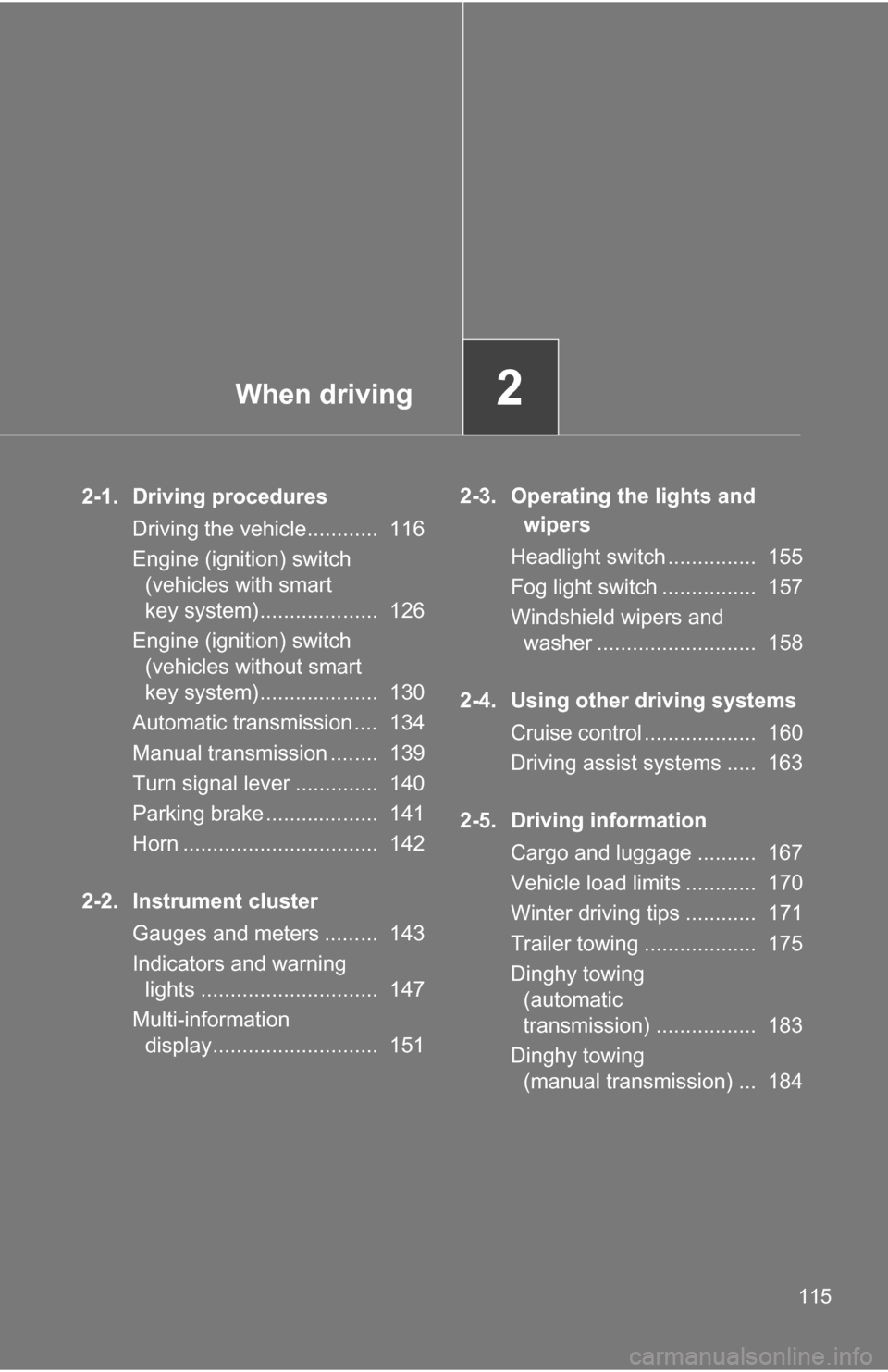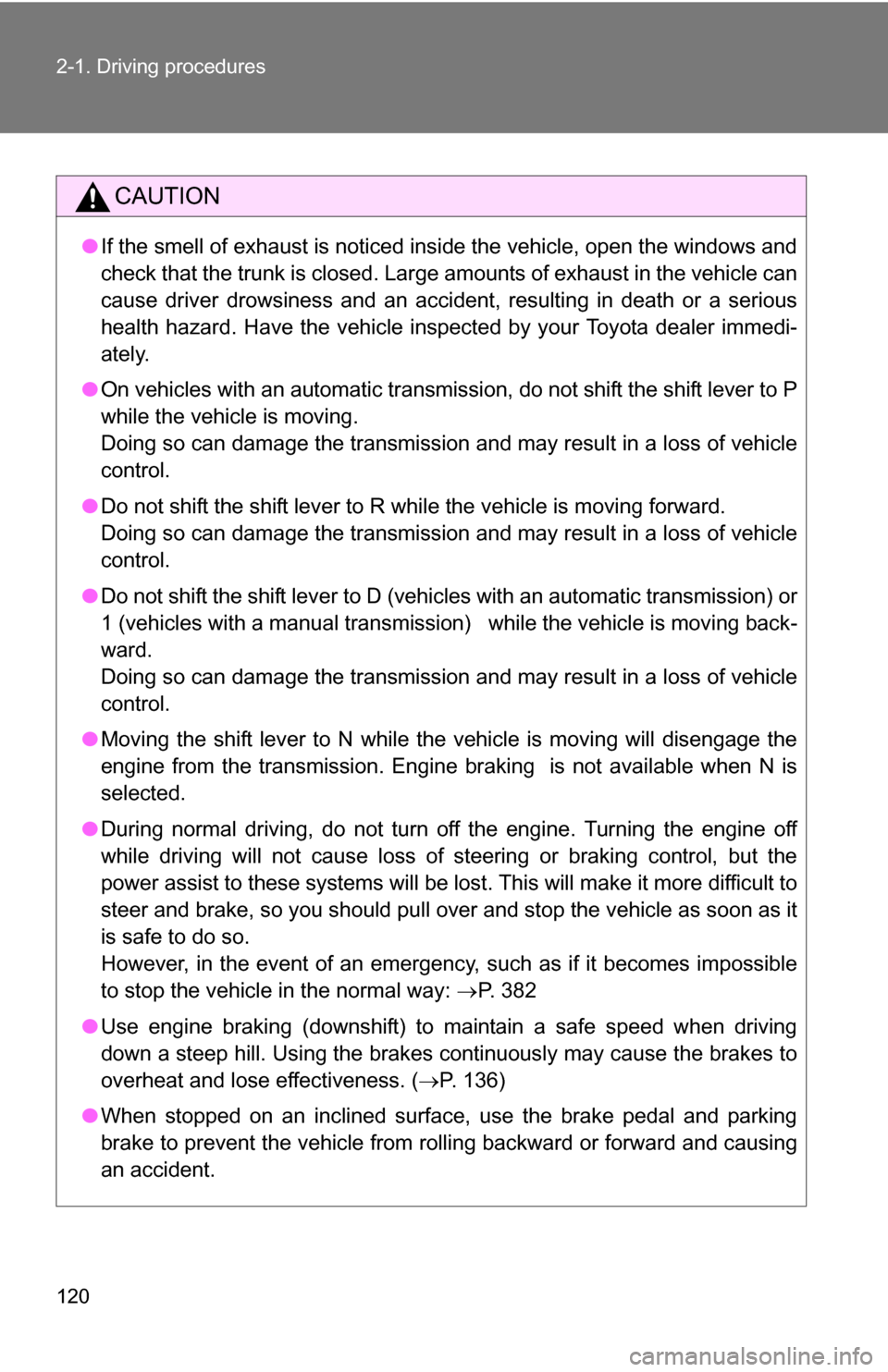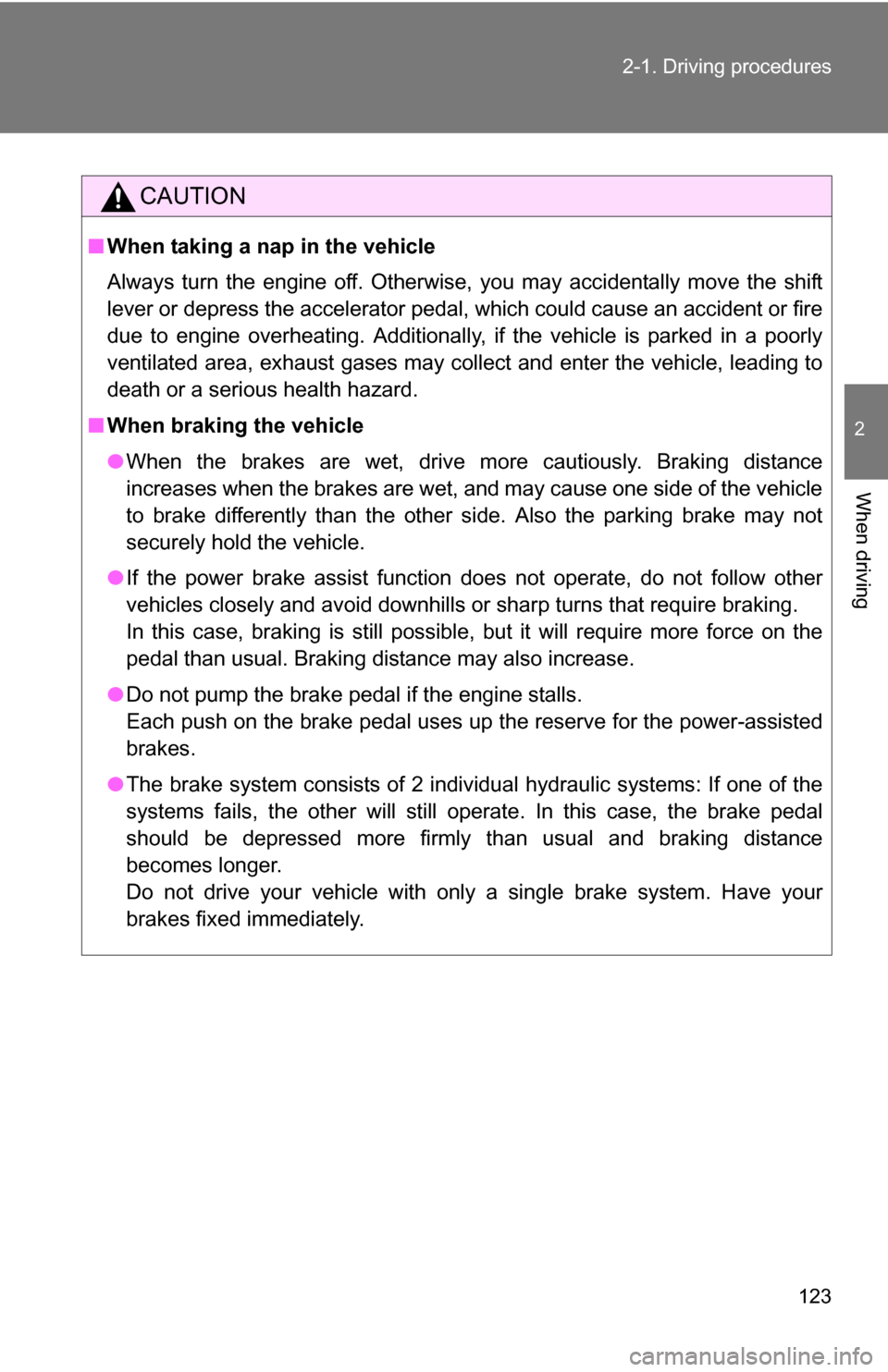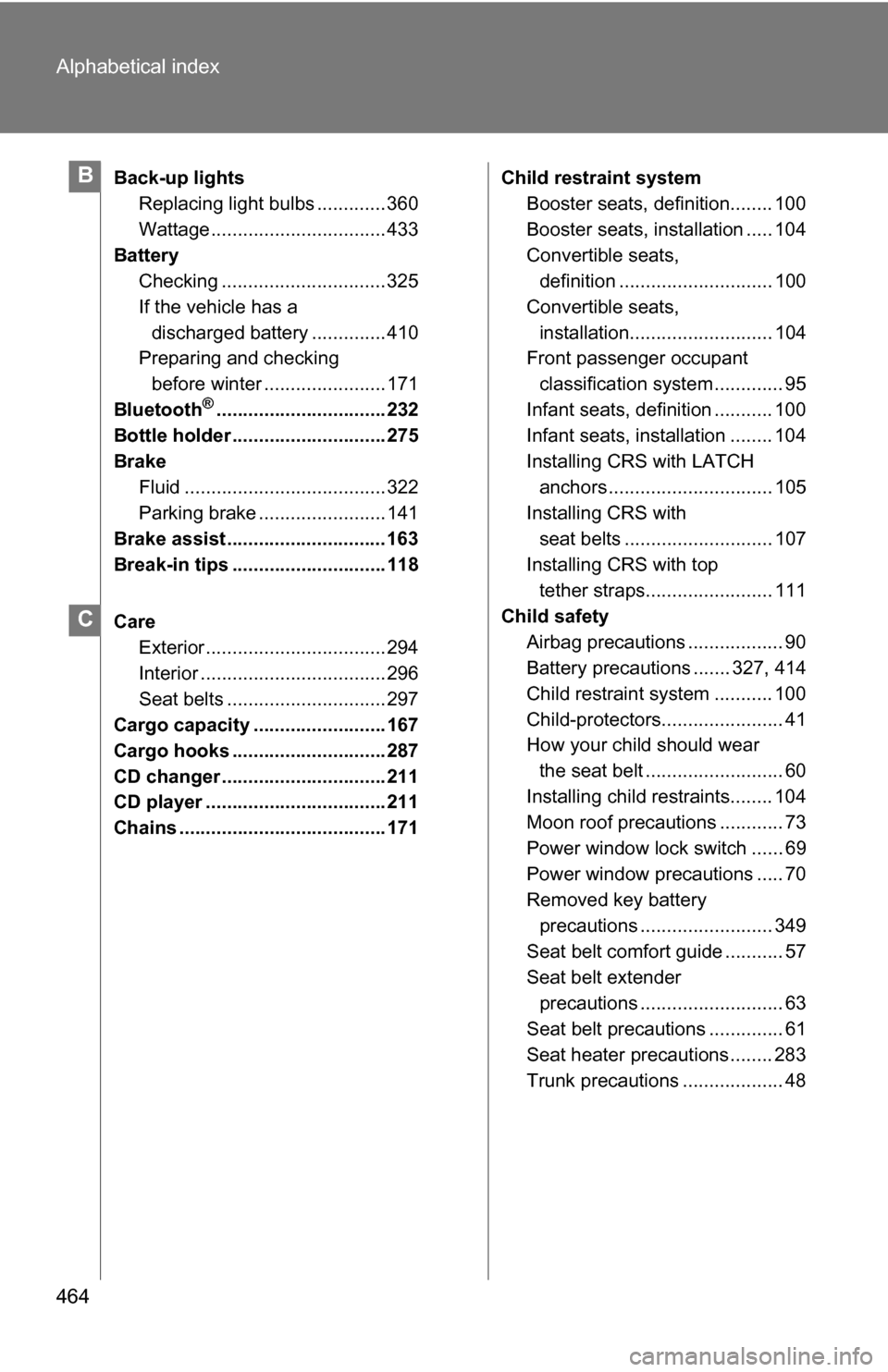Page 115 of 476

When driving2
115
2-1. Driving proceduresDriving the vehicle............ 116
Engine (ignition) switch (vehicles with smart
key system).................... 126
Engine (ignition) switch (vehicles without smart
key system).................... 130
Automatic transmission .... 134
Manual transmission ........ 139
Turn signal lever .............. 140
Parking brake ................... 141
Horn ................................. 142
2-2. Instrument cluster Gauges and meters ......... 143
Indicators and warning lights .............................. 147
Multi-information display............................ 151 2-3. Operating the lights and
wipers
Headlight switch ............... 155
Fog light switch ................ 157
Windshield wipers and washer ........................... 158
2-4. Using other driving systems Cruise control ................... 160
Driving assist systems ..... 163
2-5. Driving information Cargo and luggage .......... 167
Vehicle load limits ............ 170
Winter driving tips ............ 171
Trailer towing ................... 175
Dinghy towing (automatic
transmission) ................. 183
Dinghy towing (manual transmission) ... 184
Page 120 of 476

120 2-1. Driving procedures
CAUTION
●If the smell of exhaust is noticed inside the vehicle, open the windows and
check that the trunk is closed. Large amounts of exhaust in the vehicle can
cause driver drowsiness and an accident, resulting in death or a serious
health hazard. Have the vehicle inspected by your Toyota dealer immedi-
ately.
● On vehicles with an automatic transmission, do not shift the shift lever to P
while the vehicle is moving.
Doing so can damage the transmission and may result in a loss of vehicle\
control.
● Do not shift the shift lever to R while the vehicle is moving forward.
Doing so can damage the transmission and may result in a loss of vehicle\
control.
● Do not shift the shift lever to D (vehicles with an automatic transmission) or
1 (vehicles with a manual transmission) while the vehicle is moving back-
ward.
Doing so can damage the transmission and may result in a loss of vehicle\
control.
● Moving the shift lever to N while the vehicle is moving will disengage the
engine from the transmission. Engine braking is not available when N is
selected.
● During normal driving, do not turn off the engine. Turning the engine off
while driving will not cause loss of steering or braking control, but the
power assist to these systems will be lost. This will make it more difficult to
steer and brake, so you should pull over and stop the vehicle as soon as it
is safe to do so.
However, in the event of an emergency, such as if it becomes impossible
to stop the vehicle in the normal way: P. 382
● Use engine braking (downshift) to maintain a safe speed when driving
down a steep hill. Using the brakes continuously may cause the brakes to
overheat and lose effectiveness. ( P. 136)
● When stopped on an inclined surface, use the brake pedal and parking
brake to prevent the vehicle from rolling backward or forward and causing
an accident.
Page 123 of 476

123
2-1. Driving procedures
2
When driving
CAUTION
■
When taking a nap in the vehicle
Always turn the engine off. Otherwise, you may accidentally move the shift
lever or depress the accelerator pedal, which could cause an accident or fire
due to engine overheating. Additionally, if the vehicle is parked in a poorly
ventilated area, exhaust gases may collect and enter the vehicle, leadin\
g to
death or a serious health hazard.
■ When braking the vehicle
●When the brakes are wet, drive more cautiously. Braking distance
increases when the brakes are wet, and may cause one side of the vehicle
to brake differently than the other side. Also the parking brake may not
securely hold the vehicle.
● If the power brake assist function does not operate, do not follow other
vehicles closely and avoid downhills or sharp turns that require braking.
In this case, braking is still possible, but it will require more force on the
pedal than usual. Braking distance may also increase.
● Do not pump the brake pedal if the engine stalls.
Each push on the brake pedal uses up the reserve for the power-assisted
brakes.
● The brake system consists of 2 individual hydraulic systems: If one of the
systems fails, the other will still operate. In this case, the brake pedal
should be depressed more firmly than usual and braking distance
becomes longer.
Do not drive your vehicle with only a single brake system. Have your
brakes fixed immediately.
Page 375 of 476
5
When trouble arises
375
5-1. Essential information
■
Emergency towin g procedure
Release the parking brake.
Shift the shift lever to N.
Turn the “ENGINE START STOP” switch or the engine switch to
ACC (engine off) or ON (engine running).
CAUTION
■ Caution while towing
●Use extreme caution when towing the vehicle.
Avoid sudden starts or erratic driving maneuvers which place excessive
stress on the emergency towing eyelets and the cables or chains.
● If the engine is not running, the power assist for the brakes and steering
will not function, making steering and braking more difficult.
STEP 1
STEP 2
STEP 3
Page 464 of 476

464 Alphabetical index
Back-up lightsReplacing light bulbs ............. 360
Wattage ................................. 433
Battery Checking ............................... 325
If the vehicle has a
discharged battery .............. 410
Preparing and checking
before winter ....................... 171
Bluetooth
®................................ 232
Bottle holder ............................. 275
Brake
Fluid ...................................... 322
Parking brake ........................ 141
Brake assist .............................. 163
Break-in tips ............................. 118
Care Exterior .................................. 294
Interior ................................... 296
Seat belts .............................. 297
Cargo capacity ......................... 167
Cargo hooks ............................. 287
CD changer ............................... 211
CD player .................................. 211
Chains ....................................... 171 Child restraint system
Booster seats, definition........ 100
Booster seats, installation ..... 104
Convertible seats, definition ............................. 100
Convertible seats, installation........................... 104
Front passenger occupant
classification system ............. 95
Infant seats, definition ........... 100
Infant seats, installation ........ 104
Installing CRS with LATCH anchors ............................... 105
Installing CRS with
seat belts ............................ 107
Installing CRS with top tether straps........................ 111
Child safety Airbag precautions .................. 90
Battery precautions ....... 327, 414
Child restraint system ........... 100
Child-protectors....................... 41
How your child should wear the seat belt .......................... 60
Installing child restraints........ 104
Moon roof precautions ............ 73
Power window lock switch ...... 69
Power window precautions ..... 70
Removed key battery precautions ......................... 349
Seat belt comfort guide ........... 57
Seat belt extender precautions ........................... 63
Seat belt precautions .............. 61
Seat heater precautions ........ 283
Trunk precautions ................... 48
B
C